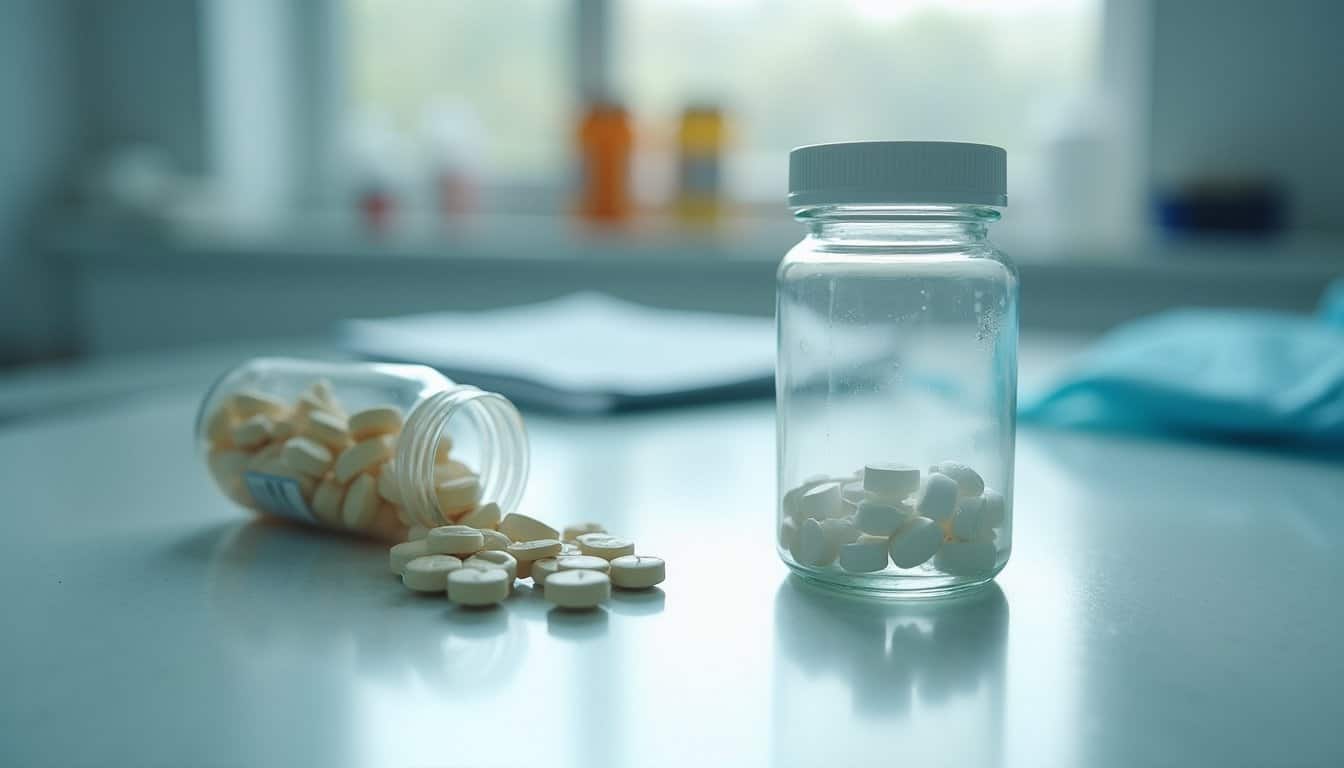Three FDA-approved medications stand out for heroin detox: methadone, buprenorphine, and naltrexone. You’ll find methadone effective for long-term treatment with once-daily dosing, while buprenorphine (often as Suboxone) offers a safer alternative with better abuse deterrence. Naltrexone blocks heroin’s effects and prevents relapse when taken as prescribed. Non-opioid options like lofexidine and clonidine can help manage withdrawal symptoms. Understanding each medication’s unique benefits will help you make an informed treatment choice. It is crucial to undergo medical supervision for heroin detox, as this ensures safety and effectiveness throughout the withdrawal process. Healthcare professionals can tailor treatment plans to individual needs, adjusting medications as necessary to manage symptoms. Combining medication with counseling and support services offers a comprehensive approach to recovery, increasing the likelihood of lasting sobriety.
Understanding Methadone: The Long-Term Solution

While various medications can support heroin detox, methadone stands out as one of the most established and effective long-term solutions. As a synthetic opioid agonist, methadone works by targeting mu-opioid receptors, effectively blocking heroin’s euphoric effects while suppressing withdrawal symptoms. Working with a key treatment worker helps ensure proper dosing and monitoring throughout the process. Additionally, many heroin detox programs include counseling and support services to address the psychological side of addiction. This combination of methadone with supportive therapies offers patients tools to manage cravings and triggers, creating a stronger path toward lasting recovery.
You’ll find that methadone’s long half-life of 24-36 hours enables once-daily dosing, maintaining stable blood levels throughout treatment. Your initial dose typically starts at 10-20 mg and can be adjusted upward in 10 mg increments until withdrawal symptoms are controlled. For maintenance therapy, you’ll likely need 80-100 mg daily to effectively suppress heroin cravings. Treatment has shown to reduce infectious disease transmission through decreased needle sharing. Withdrawal symptoms typically begin within 30 hours after stopping methadone use, making careful medical supervision essential. During the heroin detox process, it’s crucial to monitor for potential side effects of methadone, such as sedation or respiratory depression. Regular consultations with a healthcare provider can help tailor the treatment plan to individual needs and enhance recovery outcomes.
When combined with counseling and psychosocial support, you’re more likely to achieve sustained abstinence. However, you’ll need careful monitoring, as methadone can cause respiratory depression if misused.
The Rise of Buprenorphine and Suboxone Treatment
Since its FDA approval in 2002, buprenorphine has revolutionized heroin detox treatment by offering a safer and more accessible alternative to methadone. Due to its high receptor affinity, sublingual administration route is preferred for optimal absorption and therapeutic effects. Discovered in 1966, John Lewis’s research laid the groundwork for developing this revolutionary medication. You’ll find buprenorphine most effective at doses ≥16 mg/day, with studies showing markedly higher abstinence rates compared to placebo treatments. Modern addiction treatment recognizes this medication as a chronic condition treatment, similar to how insulin manages diabetes.
| Feature | Buprenorphine Advantage |
|---|---|
| Safety Profile | Lower overdose risk |
| Dosing | Flexible, less frequent |
| Access | Office-based prescribing |
| Compliance | Better retention rates |
| Treatment Length | 3-24 months customizable |
When combined with naloxone in Suboxone, you’re getting added protection against misuse while maintaining therapeutic benefits. This medication’s partial agonist properties mean you’ll experience less euphoria and face reduced risk of respiratory depression. The treatment’s proven success has led to its inclusion in the WHO’s essential medicines list and contributed to a 50% reduction in fatal overdose risk.
Naltrexone’s Role in Preventing Relapse

Although naltrexone represents a different approach from other medication-assisted treatments, it’s proven highly effective at preventing heroin relapse through its unique mechanism as a pure opioid antagonist. By blocking opioid receptors, naltrexone creates a biochemical barrier that prevents heroin from producing its euphoric effects. Monthly liver function tests and ALT monitoring are essential during treatment to ensure patient safety. Research shows that patients who experience blocked use episodes demonstrate significantly better treatment retention compared to those with unblocked use. You’ll find naltrexone available in two forms: daily oral tablets or monthly injectable Vivitrol®. Studies show that injectable naltrexone yields better outcomes due to improved adherence, with research demonstrating a 36-50% reduction in relapse rates when combined with counseling. However, you must complete full detoxification before starting naltrexone, 7 days for heroin or 14 days for methadone. Success depends on consistent dosing and commitment to treatment, as non-adherence greatly increases relapse risk. The medication works best when integrated with comprehensive therapy sessions that address both physical dependence and psychological aspects of addiction.
Non-Opioid Options for Withdrawal Management
Despite the prominence of opioid-based medications in detox programs, several non-opioid options play an essential role in managing withdrawal symptoms effectively. You’ll find that medications like Lofexidine and Clonidine can greatly reduce physical symptoms by targeting noradrenergic hyperactivity. These heroin detox medications work alongside supportive treatments to enhance recovery outcomes. Daily monitoring for hypotensive episodes is crucial when using these medications, especially in patients experiencing vomiting or diarrhea. The economic impact of implementing comprehensive detox programs has shown to reduce healthcare costs significantly compared to untreated opioid dependence.
| Medication Type | Primary Use | Key Benefit |
|---|---|---|
| Lofexidine | Withdrawal Management | FDA-approved, better safety profile |
| NSAIDs | Pain Relief | Manages muscle aches effectively |
| Antiemetics | Nausea Control | Reduces GI distress |
| Hydroxyzine | Anxiety Relief | Non-addictive alternative |
| Trazodone | Sleep Aid | Improves rest quality |
For best results, you’ll need to combine these medications with behavioral therapies, proper hydration, and nutrition support. Your healthcare provider will tailor the medication plan to address your specific withdrawal symptoms while minimizing potential risks.
Choosing the Right Medication for Your Recovery Journey

Selecting the right medication for heroin detox requires careful evaluation of multiple clinical factors that extend beyond managing withdrawal symptoms. Your treatment team will assess your opioid dependence severity, previous treatment experiences, and existing medical conditions to determine the most appropriate medication. Withdrawal management medications like lofexidine can help reduce symptoms like pain, nausea, and diarrhea during detox. Research shows that MOUD treatments with buprenorphine or methadone are most effective at reducing overdose risk.
If you’re considering methadone, you’ll need access to certified treatment programs for daily dosing. Buprenorphine offers more flexible outpatient options, while naltrexone‘s monthly injection might suit you if you’ve completed detox and have strong support systems. Supportive meds like clonidine can complement your primary treatment by addressing specific withdrawal symptoms.
Your choice should account for practical considerations, including treatment accessibility, cost, and your lifestyle demands. Remember that medication selection isn’t permanent; your provider can adjust your treatment plan based on your response and recovery progress. Studies show that staying on medication-assisted treatment indefinitely is encouraged since discontinuing pharmacotherapy significantly increases relapse risk.
Frequently Asked Questions
How Long Does the Typical Heroin Detox Medication Program Last?
You’ll typically undergo heroin detox medication programs lasting between several days to 12 weeks, depending on your specific needs. The acute phase takes 4-10 days, but if you’re using medication-assisted treatment like methadone or buprenorphine, you’ll need supervised dosing for at least 3 months. Your program length will vary based on factors including your usage history, withdrawal severity, and whether you’re in a home or medical setting.
Can I Continue Working While Taking Heroin Detox Medications?
Yes, you can continue working while taking detox medications, but you’ll need to take into account certain factors. Buprenorphine and naltrexone generally allow for normal work function, while methadone may initially affect your performance. If you’re in a safety-sensitive position, you’ll need medical clearance. You should plan for clinic visits and possible schedule adjustments during early treatment. Once stabilized on your medication, most people successfully maintain employment with proper medical supervision.
What Happens if I Miss a Scheduled Dose?
If you miss a dose, don’t take a double dose to catch up. After three consecutive missed doses, you’ll need a clinical review, and your dose may be reduced. Missing four or more doses typically requires a significant dose reduction (usually 50%). If you miss five or more doses, you’ll need a complete reassessment and will likely restart at a lower dose due to reduced tolerance, which helps prevent overdose risk.
Are Detox Medications Covered by Insurance?
Yes, most insurance providers cover detox medications, including methadone, buprenorphine, and naltrexone. You’ll find these medications are typically included in prescription drug formularies, though coverage levels vary by plan. You may need prior authorization or have to try lower-cost options first. Be aware that you’ll likely have copays or coinsurance, but generic versions usually cost less. Recent policy changes have improved coverage access nationwide.
Can I Travel Internationally While on Heroin Detox Medications?
Yes, you can travel internationally with heroin detox medications, but you’ll need to carefully prepare. You must obtain proper documentation, including a valid prescription and potentially additional permits from authorities. Always research your destination’s specific regulations, as laws vary widely between countries. Carry medications in their original packaging, bring translated prescriptions, and contact the embassy or consulate beforehand to guarantee compliance with local drug control laws.










